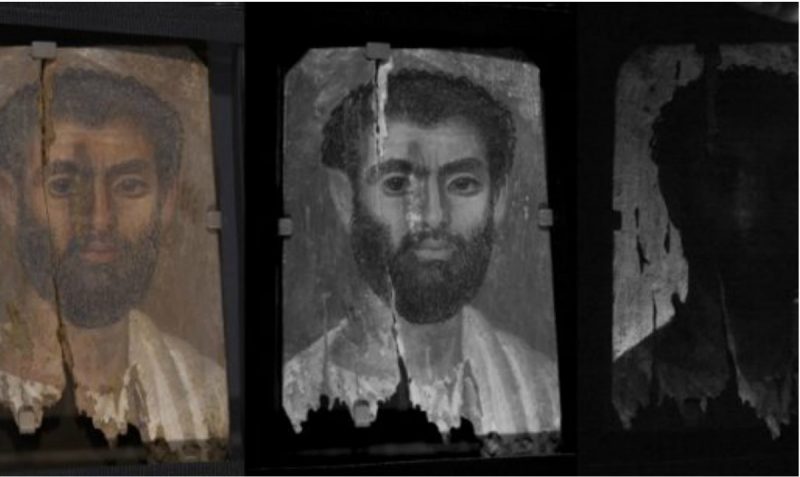For about 100 years, a collection of 15 Egyptian mummy paintings almost 2 millennia old remained forgotten, until scientists and art conservators from the Northwestern University and the Phoebe A. Hearst Museum of Anthropology decided to dust them off and attempt to analyze the materials that painters used to produce them.
It turned out to be a well-thought-out decision. A closer inspection of the portraits, using novel imaging and color-analysis technologies, has revealed that the works, intriguingly enough, contained a pigment called Egyptian blue.
Eleven of the paintings were mummy portraits, and four were fragments of images retrieved in 1889 and 1900 from an Ancient Egyptian site named Tebtunis, today known as Umm el-Baragat, roughly 90 miles from Cairo. Though these ancient artworks were found over a century ago, their discovery at the time had been shadowed by other findings on the site, such as papyri. The research team revisiting the portraits, led by archaeological scientist Dr. Marc Walton from Northwestern University, revealed their findings in August 2015 in the journal Applied Physics A.

Before the new discovery surfaced that Egyptian blue pigment was used for the mummy portraits, researchers believed that the color was used only for very special occasions. Egyptian blue is one of the first artificial pigments to be used, as early as 5,000 years ago. Also known as calcium copper silicate, it was considered very valuable due to effort needed in order to produce it.
But when studying the mummy paintings, the blue pigment was identified in five of the 15 pieces. Moreover, analysis has shown that the pigment was solely used for doing the first sketches of the portraits and for color modulation, which means the Egyptian blue cannot be spotted by the naked eye as it was hidden beneath layers of later applied colors. It came as a surprise that ancient artists had opted to keep the pigment beneath other layers. Such a finding, as commentaries go, had never before been documented.
“This defies our expectations for how Egyptian blue would be used” was one of the comments made by Walton. The portraits were dated to the period between the 1st and the 3rd centuries A.D., in the time of the great Roman Empire. The Egyptian artists of the period would paint the face of the deceased on panels made of wood, and the portraits were then used to cover the face of the mummified bodies. Three of the pictures were also said to have been done by the same artist.
“The discovery changes our understanding of how this particular pigment was used by artists in the second century A.D,” Walton remarked. “I suspect we will start to find unusual uses of this colorant in a lot of different works of art, such as wall paintings and sculpture.”
Reportedly, during that same period, painters were noted for imitating Greek art, in which yellow, white, red, and black appeared as the dominant colors, and Greek artists were perceived as the most exemplary artists of all. The Greeks would have traditionally avoided the use of blue, which was not the same case in ancient Egypt before Greeks established their influence and power, after founding Alexandria. Before then, Egyptian blue found common usage in art even beyond Egypt, across various territories on the Mediterranean.
However, yellow, white, red, and black are precisely the colors that one can notice on the portraits from Tebtunis. “But when we started doing our analysis, all of a sudden we started to see strange occurrences of this blue pigment, which luminesces,” Walton said. “We concluded that although painters were trying hard not to show they were using the color, they were definitely using blue.”
There isn’t much space for doubt that Roman-Egyptian artists took some similar, if not the same, styles and techniques employed by Greek artists, to produce these astonishing images where heads of people come in close-up, and bright colors dominate. More than that, the same styles lingered on and later influenced painters and artists of the Late Middle Ages, as well as the pre-Renaissance period. Researchers have remarked that the techniques are evident in many examples of art from that age, including icons of Christ as well as of the Virgin Mary, depictions and examples of which are found in art across both the Catholic and Orthodox churches.
Besides that, more findings have affirmed that the mummy paintings are of international interest, as many of the colors were brought from other countries, such as Greece or Spain. The wood used for doing the portraits originated as far as Central Europe, pointing to the existence of a well-developed trading network through which the ancient portrait-makers obtained their treasured resources.
Intact since their excavation, today the Tebtunis portraits make for an invaluable treasure of the University of California, Berkeley. The collection is at the same time considered to be also one of the largest of Roman-Egyptian mummy portraits around the world.
